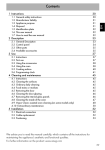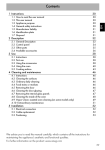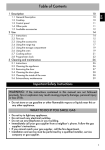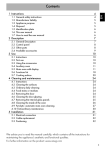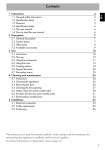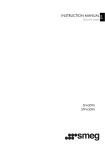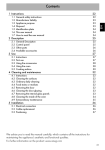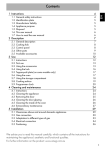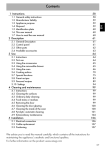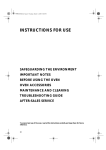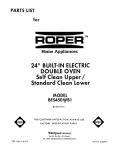Download Table of Contents
Transcript
Table of Contents 1.1 1.2 1.3 1.4 8 General Description Control panel Other parts Available accessories 2 Use 2.1 2.2 2.3 2.4 2.5 2.6 EN 1 Description 8 8 9 10 11 Instructions First use Using the accessories Using the oven Cooking advice Programmer clock 3 Cleaning and maintenance 3.1 Instructions 3.2 Cleaning the surfaces 3.3 Ordinary daily cleaning 3.4 Food stains or residues 3.5 Removing the door 3.6 Cleaning the door glass 3.7 Removing the internal glass panels 3.8 Cleaning the inside of the oven 3.9 Vapor Clean 3.10 Extraordinary maintenance 11 11 12 12 14 16 20 20 20 20 20 21 21 22 23 24 25 Important Safety Instructions WARNING: If the instructions contained in this manual are not followed precisely, fire or explosion may result causing property damage, personal injury or loss of life. READ AND SAVE THESE INSTRUCTIONS - Your safety and the safety of others are very important. We have provided many important safety messages throughout this manual and on the appliance. Read all the instructions before using the appliance and always obey all safety messages. 3 Important Safety Instructions RECOGNIZE SAFETY INFORMATION This is a safety alert symbol. This symbol alerts you to potential hazards that can result in severe personal injury or loss of life. UNDERSTAND SIGNAL WORDS A signal word - DANGER, WARNING or CAUTION - is used with the safety alert symbol. DANGER denotes the most serious hazards. It means you could lose your life or be seriously injured if you do not immediately follow the instructions. WARNING means you could lose your life or be seriously injured if the instructions are not followed. CAUTION indicates a potentially hazardous situation which, if not avoided, could result in minor to moderate injury. WARNING • This appliance is intended for use in the home only. • Use this appliance only for its intended purpose. The manufacturer cannot be held liable for damage caused by improper use of this appliance. • This appliance complies with current safety regulations. Improper use of this appliance can result in personal injury and material damage. • Read all the instructions before installing or using the appliance for the first time. • Keep these operating instructions in a safe place and pass them on to any future user. The safety messages will inform you of potential hazards, on how to avoid the risk of injury and what can occur if the instructions are not followed. IMPORTANT: Observe all codes and ordinances in force. WARNING: For your safety, the instructions contained in this manual must be followed to minimize the risk of fire or explosion and to prevent property damage, personal injury or loss of life. Do not store or use gasoline or other flammable vapors, liquids or materials near this or any other appliance. NOTE: This appliance is NOT designed for installation in manufactured (mobile) homes or in recreational vehicles (RVs). DO NOT install this appliance outdoors. 4 WARNING To reduce the risk of fire, electrical shock, personal injury, or damage when using the appliance, follow basic safety precautions, including the following: • Read all instructions. • Proper installation is your responsibility. Have a qualified technician install and ground this appliance in accordance with these installation instructions. • It is the responsibility of the installer to comply with installation information specified on the model/serial ID plate. The ID plates are visibly located on the back of the appliance and on the oven door frame. These ID plates must never be removed. • Proper installation is your responsibility. Make sure your appliance is properly installed and grounded by a qualified installer. • WARNING: NEVER use this appliance as a space heater to heat or warm the room. Doing so may result in overheating of the oven. • DO NOT LEAVE CHILDREN UNATTENDED: Children should not be left alone or unattended in the area where the appliance is being used. Never allow children to sit or stand on any part of the appliance. • CAUTION: Do not store items of interest to children in cabinets above a range or on the backguard of a range - children climbing on the range to reach items could be seriously injured. • WEAR PROPER APPAREL: Loose-fitting or hanging garments should never be worn while using the appliance. • For safety reasons and to avoid damage to your appliance, never sit, stand or lean on the oven door. • FLAMMABLE MATERIALS SHOULD NEVER BE STORED IN THE OVEN. • DO NOT TOUCH THE INSIDE OF THE APPLIANCE: Heating elements may be hot even though they are dark in color. The oven cavity can be hot enough to cause burns. During and after use, do not touch areas inside of the oven until they have had sufficient time to cool. Do not allow garments or any flammable material to come into contact with hot surfaces. If personal clothing or hair catches on fire, drop and roll immediately to extinguish the flames. • PLACE THE OVEN RACKS IN THE DESIRED POSITION WHILE THE OVEN IS COOL: If a rack must be removed while the oven is hot, do not allow the potholders to come in contact with the broiler burner. • USE CAUTION WHEN OPENING THE OVEN DOOR: Allow hot air or steam to escape before removing or placing foods in the oven. • Do not leave the packing materials around the home. Sort the various items of waste and take them to the nearest specialized waste collection facility. • Do not obstruct oven vents or openings for air intake. 5 EN Important Safety Instructions Important Safety Instructions • ELECTRICAL GROUNDING IS REQUIRED. It is the customer’s responsibility: 1. To contact a qualified electrician. 2. To ensure that the electrical system is adequate and in compliance with the National Electrical Code ANSI / NFPA 70 Electrical Code – latest edition – or the CANADIAN ELECTRICAL CODE, C22.11 – 1982 and C22.2 No. 01982 – or latest edition – and all local codes and ordinances. • Always check that the controls are in the "zero" (off) position when the oven is not in use. • Do not attempt to repair or replace any part of this appliance unless specifically recommended in this manual. All other servicing should be done by a qualified technician. • Never use any part of the oven for storage. Flammable materials can ignite and plastic items may melt or burst into flame. • Do not hang articles on any part of the appliance or place anything against the oven. Some fabrics are extremely flammable and could ignite. • DO NOT USE ALUMINUM FOIL TO LINE ANY PART OF THE OVEN. Use of a foil liner can result in an electrical shock or fire hazard or obstruct the flow of heat and air. Foil is an excellent heat insulator, allowing heat to be trapped under it. This can interfere with cooking and can damage the enamel of the oven. • Prevent aluminum foil from contacting the heating elements. • DO NOT HEAT UNOPENED FOOD CONTAINERS: A buildup of pressure can cause the containers to burst. • DO NOT USE FLAMMABLE PRODUCTS TO CLEAN THE OVEN. • Do not clean, rub, damage or remove the oven door gasket. It is essential for a good, tight seal during baking and when the self-clean cycle is engaged. Replace the oven door gasket if it becomes damaged or encrusted with food residue. • ONLY QUALIFIED SERVICE PERSONNEL SHOULD PERFORM REPAIRS. Service personnel must disconnect the power supply before servicing this unit. NOTE: The California Safe Drinking Water and Toxic Enforcement Act requires the Governor of California to publish a list of substances known to the State of California to cause cancer, birth defects or other reproductive harm, and requires businesses to warn customers of potential exposure to such substances. WARNING: This product contains a chemical known by the State of California to cause cancer, birth defects or other reproductive harm. This appliance can cause low-level exposure to some of the substances listed, including benzene, formaldehyde, carbon monoxide, toluene, and soot. 6 • Do Not Use Water on Grease Fires Smother fire or flame or use dry chemical or foam-type extinguisher. • Use Only Dry Potholders - Moist or damp potholders on hot surfaces may result in burns from steam. Do not let potholder touch hot heating elements. Do not use a towel or other bulky cloth. • Do not stand or sit on the oven door. • Remove all packing materials and temporary labels from the oven. • Record the Model and Serial number on Page 2 of this booklet. The Model and Serial numbers are on the appliance ID plate. The ID plates are visibly located on the oven door frame. THE ID PLATE MUST NOT BE REMOVED. • BEFORE BAKING FOR THE FIRST TIME, turn on the oven to burn off any dirt, oil or grease remaining from the manufacturing process. Turn the oven on and set to 450°F (230°C) for 20 to 30 minutes. How to read the user manual This user manual uses the following reading conventions: Instructions General information on this user manual, on safety and final disposal. Description Description of the appliance and its accessories. Use Information on the use of the appliance and its accessories, cooking advice. Cleaning and maintenance Information for proper cleaning and maintenance of the appliance. Safety instructions Information Advice 1. Use instruction sequence. • Single use instruction. SAVE THESE INSTRUCTIONS 7 EN Important Safety Instructions Description 1 Description 1.1 General Description 1 Control panel 2 Oven light 3 Seal 4 Door 1.2 Control panel 8 5 Fan 6 Rack/tray support frames Frame shelf 1 Temperature knob 1.3 Other parts This knob allows you to select the cooking temperature and the Vapor Clean temperature (on some models only). Turn the knob clockwise to the required value, between the minimum and maximum settings. Oven shelves 2 Thermostat indicator light When the indicator light is flashing, it indicates that the oven is heating up to reach the set temperature. Once the temperature has been reached, the light remains lit until the oven is turned off. In pyrolytic models, the light switches on when the automatic cleaning cycle (pyrolysis) starts and remains lit until the cycle is complete. 3 Programmer clock Useful for displaying the current time, setting programmed cooking operations and setting the timer. 4 Function knob The oven's various functions are suitable for different cooking modes. After selecting the required function, set the cooking temperature using the temperature knob. EN Description The oven features shelves for positioning trays and racks at different heights. The insertion heights are indicated from the bottom upwards (see 1.1 General Description). Cooling fan The fan cools the oven and comes into operation during cooking. The fan causes a steady outflow of air from above the door which may continue for a brief period of time even after the appliance has been turned off. Internal light The oven light comes on when the door is opened or any function is selected. 9 Description 1.4 Available accessories Deep tray Some models are not provided with all accessories. Rack Useful for collecting fat from foods placed on the rack above and for cooking pies, pizzas and baked desserts. Useful for holding cooking containers. Tray rack The oven accessories intended to come into contact with food are made of materials that comply with the provisions of current legislation. Original and optional accessories can be requested to Authorized Assistance Centers. Use only original accessories supplied by the manufacturer. To be placed over the top of the oven tray; for cooking foods which may drip. 10 Use 2.1 Instructions High temperature inside the oven during use Danger of burns • Keep the oven door closed during cooking. • Protect your hands using heat resistant gloves when moving food inside the oven. • Do not touch the heating elements inside the oven. • Do not pour water directly on very hot trays. • Do not allow children to get near the oven when it is in operation. High temperature inside the oven during use Danger of fire or explosion • Do not spray any spray products near the oven. • Do not use or leave flammable materials near the oven. • Do not use plastic kitchenware or containers when cooking food. • Do not put sealed cans or containers in the oven. • Do not leave the oven unattended during cooking operations where fats or oils could be released. • Remove from the oven compartment all trays and racks not used during cooking. Improper use Risk of damage to enamelled surfaces EN 2 Use • Do not cover the bottom of the oven with aluminum or tin foil sheets. • If you wish to use greaseproof paper, place it so that it will not interfere with the hot air circulation inside the oven. • Do not place pans or trays directly on the bottom of the cooking compartment. • Do not pour water directly on very hot trays. 2.2 First use 1. Remove any protective film from the outside or inside of the appliance, including accessories. 2. Remove any labels (apart from the technical data plate) from trays, dripping pans and the cooking compartment. 3. Remove and wash all the appliance accessories (see 3 Cleaning and maintenance). 4. Heat the empty oven at the maximum temperature to burn off any residues left by the manufacturing process. 11 Use 2.3 Using the accessories Tray rack Racks and trays The tray rack must be inserted into the tray. In this way fat can be collected separately from the food which is being cooked. Racks and trays must be inserted into the side guides until they come to a complete stop. • The mechanical safety locks that prevent the rack from being taken out accidentally must face downwards and towards the oven back. 2.4 Using the oven Turning the oven on To turn the oven on: 1. Select the cooking function using the function knob. 2. Select the temperature using the temperature knob. Gently insert racks and trays into the oven until they come to a stop. Clean the trays before using them for the first time to remove any residues left by the manufacturing process. 12 Functions list Static As the heat comes from above and below at the same time, this system is particularly suitable for certain types of food. Traditional cooking, also known as static cooking, is suitable for cooking just one dish at a time. Perfect for all types of roasts, bread and cakes and particularly suitable for fatty meats such as goose and duck. Broiler The heat coming from the broiler element gives perfect broiling results above all for thin and medium thickness meat and, in combination with the rotisserie (where fitted), gives the food an even browning at the end of cooking. Perfect for sausages, ribs and bacon. This function enables large quantities of food, particularly meat, to be grilled evenly. Bottom The heat coming just from the bottom allows you to complete the cooking of foods that require a higher bottom temperature, without affecting their browning. Perfect for cakes, pies, tarts and pizzas. Turbo The combination of convection cooking and traditional cooking allows different foods to be cooked on several levels extremely quickly and efficiently, without odors and flavors mingling. Perfect for large volumes that call for intense cooking. Defrost Rapid defrosting is helped by switching on the fan provided and the top heating element that ensure uniform distribution of low temperature air inside the oven. Static + fan The operation of the fan, combined with traditional cooking, ensures uniform cooking even with complex recipes. Perfect for cookies and cakes, even when simultaneously cooked on several levels. (For multiple-level cooking, we recommend using the 2nd and 4th shelves.) Convection broil The air produced by the fan softens the strong heatwave generated by the broiler, roasting even very thick foods perfectly. Perfect for large cuts of meat (e.g. pork shank). 13 EN Use Use Convection bake The combination of the fan and the convection heating element (incorporated in the rear of the oven) allows you to cook different foods on several levels, as long as they need the same temperatures and same type of cooking. Hot air circulation ensures instant and uniform distribution of heat. It will be possible, for instance, to cook fish, vegetables and cookies simultaneously (on different levels) without mixing odors and flavors. Small broiler + convection Through the combined action of the fan and the heat of the central element only, this function is perfect for rapid cooking and au gratin cooking of small quantities of food (particularly meats), by bringing together the dietary advantages of the broiler and the even cooking of the fan. Bottom + fan The combination of the fan with just the bottom heating element allows cooking to be completed more rapidly. This system is recommended for sterilizing or for finishing off the cooking of foods which are already well-cooked on the surface, but not inside, and therefore need a little more heat. Perfect for any type of food. In pyrolytic models, the special defrost and proofing functions are brought together under the same function. 14 Vapor Clean This function makes cleaning easier using the steam produced by a little quantity of water poured onto the appropriate drawing placed on the bottom. 2.5 Cooking advice General advice • Use a convection function to achieve uniform cooking at several levels. • It is not possible to shorten cooking times by increasing the temperature (the food could be overcooked on the outside and undercooked on the inside). Advice for cooking meat • Cooking times vary according to the thickness and quality of the food and to consumer taste. • Use a meat thermometer when roasting meat, or simply press on the roast with a spoon. If it is hard, it is ready; if not, it needs another few minutes of cooking. Advice for cooking with the Broiler and Convection broil • Meat can be grilled even when it is put into the cold oven or into the preheated oven if you wish to change the effect of the cooking. • With the Convection broil function, we recommend that you preheat the oven before grilling. • We recommend placing the food at the center of the rack. • With the Broiler function, we recommend that you turn the temperature knob to the maximum value near the symbol to optimize cooking. Advice for cooking desserts/pastries and cookies • Use dark metal baking pans/sheets: they help to absorb the heat better. • The temperature and the cooking time depend on the quality and consistency of the dough. • To check whether the dessert is cooked right through: at the end of the cooking time, put a toothpick into the highest point of the dessert. If the dough does not stick to the toothpick, the dessert is cooked. • If the dessert collapses when it comes out of the oven, next time reduce the set temperature by about 50°F, selecting a longer cooking time if necessary. Advice for defrosting and proofing • Place frozen foods without their packaging in a lidless container on the first shelf of the oven. • Avoid overlapping the food. • To defrost meat, use the rack placed on the second level and a tray on the first level. In this way, the liquid from the defrosting food drains away from the food. • The most delicate parts can be covered with aluminum foil. • For successful proofing, a container of water should be placed in the bottom of the oven. To save energy • Stop cooking a few minutes before the time normally used. Cooking will continue for the remaining minutes with the heat which has accumulated inside the oven. • Reduce any opening of the door to a minimum to avoid heat dispersal. • Keep the inside of the appliance clean at all times. 15 EN Use Use 2.6 Programmer clock Timed cooking Timed cooking is the function that allows a cooking operation to be started and then ended after a specific length of time set by the user. 1. After selecting a cooking function and temperature, press the key . The pointer moves to position 12 and the symbol will flash on the display. 1 Timer key 2 End of cooking key 3 Time setting and reset key 4 Value decrease key 5 Value increase key Setting the time On the first use, or after a power failure, the display flashes at regular intervals. Press to stop the flashing. Press again for two seconds to start the procedure for setting the current time. Use the keys or to increase or decrease the time value by one minute each time you press until the correct time has been set. The clock starts working 5 seconds after the last key press. 2. To set the cooking time, press the key or within 5 seconds: each pressure on adds 1 minute to the cooking time, and every 12 minutes a new internal segment will light up (the example below shows a cooking time of 1 hour). 3. Once the required time is obtained, cooking will start about 5 seconds after the last press on or . 16 4. The display will show the current time, represented by the constantly illuminated segments, and the minutes left to the end of cooking, represented by the flashing segments (each flashing segment means 12 minutes of cooking time left). 5. At the end of cooking, the timer will switch the oven heating elements off, the buzzer will start to sound and the numbers on the dial will flash. 6. The set program can be cancelled: press the key for 2 seconds to cancel the set time and switch the oven off manually if a cooking operation is in progress. It is not possible to set a cooking time of more than 12 hours. Programmed cooking Programmed cooking is the function that allows a cooking operation to be started at a set time and then ended after a specific length of time set by the user. 1. Set the cooking time as described in the previous point “Timed cooking”. 2. Within 5 seconds of last pressing the key or , press the key again to set the cooking end time. The symbol will flash on the display together with the current time, with the internal segments illuminated to show the end of cooking time. 3. Press the key or to set the cooking end time. 4. 5 seconds after the last key is pressed, the display will show the current time and the cooking start and end times, which will be represented by the illuminated internal segments. As soon as the current time reaches the set cooking start time, the internal segments will flash and the oven will start cooking. 5. At the end of cooking, the timer will switch the oven heating elements off, the buzzer will start to sound and the numbers on the dial will flash. 6. The set program can be cancelled: press the key for 2 seconds to cancel the set time and switch the oven off manually if a cooking operation is in progress. • In the example below, the current time is 7.06 and cooking is programmed to start at 8.00 and end at 9.00. • At 8 o'clock, the internal segments between 8 and 9 will start to flash. For the oven to start cooking after the programming procedures just described, the knobs must be correctly set on the required temperature and function. 17 EN Use Use Reducing display brightness To reduce energy consumption in stand-by, briefly press the key to reduce the display brightness. To restore the normal brightness, press again. 3. Five seconds after last pressing the key, the countdown begins, at the end of which the buzzer activates. 4. During the countdown, the current time can be displayed by pressing . 5. Press again to return to the timer display. Timer This function only activates the buzzer, without stopping cooking. 1. Press and the display will light up as shown in the figure below. At the end of the countdown, turn the temperature and function knobs to O to manually stop the cooking operation. It is not possible to set a cooking time of more than 4 hours. 2. Within 5 seconds, press the key or to set the timer. Each time a key is pressed, an outer segment representing 1 minute of cooking is lit or switched off (the example below shows a countdown of 1 hour and 10 minutes). 18 Use Food Weight (lbs.) Function Lasagna Baked pasta 6,6 - 8,8 6,6 - 8,8 Static Static Roast veal Pork Sausages Roast beef Roast rabbit Turkey breast Roast pork neck Roast chicken 4,4 Turbo 4,4 Turbo 3,3 Convection broil 2,2 Turbo 3,3 Convection bake 6,6 Turbo 4,4 - 6,6 Turbo 2,6 Turbo Runner posi- Temperature tion from the (°F) bottom 1 410 - 450 1 410 - 450 2 2 4 2 2 2 2 2 360 360 500 500 360 360 360 360 EN Cooking information chart Time (minutes) 45 - 50 45 - 50 90 - 100 70 - 80 15 40 - 45 70 - 80 110 - 120 170 - 180 65 - 70 1st surface 2nd surface 15 10 7 10 10 5 10 8 5 7 Pork chops Spare ribs Bacon Pork fillet Beef fillet 3,3 3,3 1,5 3,3 2,2 Convection broil Convection broil Broiler Convection broil Broiler 4 4 5 4 5 500 500 500 500 500 Salmon trout Monkfish Turbot 2,6 3,3 3,3 Turbo Turbo Turbo 2 2 2 300 300 300 35 - 40 60 - 65 45 - 50 Pizza Bread Focaccia 2,2 2,2 2,2 Turbo Convection bake Turbo 2 2 2 500 360 - 410 360 8-9 25 - 30 20 - 25 Sponge cake Jam tart Ricotta cake Jam tarts Paradise cake Cream puffs Light sponge cake Rice pudding Brioches 2,2 2,2 2,2 2,2 2,6 2,6 2,2 2,2 1,3 Convection bake Convection bake Convection bake Turbo Convection bake Turbo Convection bake Turbo Convection bake 2 2 2 2 2 2 2 2 2 300 300 300 - 360 300 300 360 300 - 360 300 300 55 - 60 35 - 40 55 - 60 20 - 25 55 - 60 80 - 90 55 - 60 55 - 60 30 - 35 The times indicated in the table do not include preheating times and are provided as a guide only. 19 Cleaning and Maintenance 3 Cleaning and maintenance 3.1 Instructions Improper use Risk of damage to surfaces • Do not use steam jets for cleaning the appliance. • Do not use cleaning products containing chlorine, ammonia or bleach on steel parts or parts with metallic finishes on the surface (e.g. anodizing, nickel- or chromium-plating). • Do not use abrasive or corrosive detergents on glass parts (e.g. powder products, stain removers and metallic sponges). • Do not use rough or abrasive materials or sharp metal scrapers. • Keeping appliance area clear and free from combustible materials, gasoline and other flammable vapors and liquids. • Not obstructing the flow of combustion and ventilation air. 3.2 Cleaning the surfaces To keep the oven surfaces in good condition, they should be cleaned regularly after use. Let them cool first. 20 3.3 Ordinary daily cleaning Always use only specific products that do not contain abrasives or chlorine-based acids. Pour the product onto a damp cloth and wipe the surface, rinse thoroughly and dry with a soft cloth or a microfiber cloth. 3.4 Food stains or residues Do not use metallic sponges or sharp scrapers as they will damage the surfaces. Use ordinary non-abrasive products with the aid of wooden or plastic utensils if necessary. Rinse thoroughly and dry with a soft cloth or a microfiber cloth. Do not allow residues of sugary foods (such as jam) to set inside the oven. If left to set for too long, they might damage the enamel lining of the oven. 3.5 Removing the door For easier cleaning, the door can be removed and placed on a cloth. To remove the door proceed as follows: 1. Open the door completely and insert two pins into the holes on the hinges indicated in the figure. 2. Grasp the door on both sides with both hands, lift it forming an angle of around 30° and remove it. 3. To reassemble the door, put the hinges in the relevant slots in the oven, making sure that grooved sections A are resting completely in the slots. Lower the door and once it is in place remove the pins from the holes in the hinges. 3.6 Cleaning the door glass The glass in the door should always be kept thoroughly clean. Use absorbent paper towels. In case of stubborn dirt, wash with a damp sponge and an ordinary detergent. We recommend the use of cleaning products distributed by the manufacturer. 21 EN Cleaning and Maintenance Cleaning and Maintenance 3.7 Removing the internal glass panels For easier cleaning the door internal glass panels can be disassembled. 1. Remove the internal glass panel by pulling the rear part gently upwards, following the movement indicated by the arrows (1). 2. Then, pull the front part upwards (2). In this way, the 4 pins attached to the glass detach from their housings in the oven door. 4. Clean the external glass panel and the panels previously removed. Use absorbent kitchen roll. In case of stubborn dirt, wash with a damp sponge and neutral detergent. 5. Replace the panels in the reverse order in which they were removed. 6. Reposition the internal glass panel. Take care to centre and insert the 4 pins into their housings in the oven door by applying slight pressure. 3. Some multifunction models have an intermediate glass panel. Remove the intermediate glass panel by lifting it upwards. 22 3.8 Cleaning the inside of the oven Removing racks/trays support frames For the best oven upkeep, clean it regularly after allowing it to cool. Take out all removable parts. Removing the guide frames enables the sides to be cleaned more easily. This operation should be performed each time the automatic cleaning cycle is used (only on some models). To remove the guide frames, pull the frame towards the inside of the oven to unhook it from its groove A, then slide it out of the seats B at the back. When cleaning is complete, reverse the above procedures to put the guide frames back in. Clean the oven racks with warm water and non-abrasive detergent. Carefully rinse and dry the damp parts. The oven should be operated at the maximum temperature for about 15-20 minutes after the use of specific products to burn off the residues left inside the oven. For easier cleaning, remove the door. 23 EN Cleaning and Maintenance Cleaning and Maintenance 3.9 Vapor Clean Vapor Clean is an assisted cleaning procedure which facilitates the removal of dirt. With this process, it is possible to clean the inside of the oven very easily. The dirt residues are softened by the heat and water vapor for easier removal afterwards. • Pour approx. 40 cc of water onto the floor of the oven. Make sure it does not overflow out of the cavity. Improper use Risk of damage to surfaces • Remove from the inside of the oven any food residues or large spills from previous cooking operations. • Carry out assisted oven cleaning operations only when the oven is cold. • Spray a water and mild liquid detergent inside the oven using a spray nozzle. Direct the spray against the side walls, upwards, downwards and towards the deflector. Preliminary operations Before starting the Vapor Clean cycle: • Completely remove all accessories from inside the oven. The roof lining can be left inside the oven. • Close the door. We recommend spraying approx. 20 times at the most. 24 Cleaning and Maintenance 1. Turn the function knob and the temperature knob to the symbol. 2. Set a cooking time of 18 minutes using the cooking time procedure described in more detail in “Programmed cooking”. 3. The Vapor Clean cycle starts approximately 6 seconds after the last press on the programmer's keys. 4. At the end of the Vapor Clean cycle, the timer will deactivate the oven heating elements, the buzzer will start to sound and the numbers on the dial will flash. 3.10 Extraordinary maintenance EN Vapor Clean setting Live parts Danger of electrocution • Disconnect the oven power supply. Replacing the internal light bulb 1. Completely remove all accessories from inside the oven. 2. Remove the racks/trays support frames. 3. Remove the bulb cover using a tool (e.g. a screwdriver). End of the Vapor Clean cycle 5. Open the door and wipe away the less stubborn dirt with a microfiber cloth. 6. Use an anti-scratch sponge with brass filaments on tougher encrustations. 7. In case of grease residues, use specific oven cleaning products. 8. Remove the water left inside the oven. 9. For improved hygiene and to avoid food being affected by any unpleasant odors, we recommend drying the oven using a convection function at 320°F for approximately 10 minutes. 4. Slide out and remove the light bulb. We recommend that you use rubber gloves for these operations. For easier manual cleaning of the parts that are difficult to reach, we recommend that you remove the door. Do not touch the halogen light bulb directly with your fingers. Wrap it in an insulating material. 25 Cleaning and Maintenance 5. Replace the bulb with one of the same type (40W). 6. Replace the cover correctly, so that the shaped part of the glass is facing the door. 7. Press the cover down as far as it will go so that it attaches completely to the bulb support. Removing the door seal To permit thorough cleaning of the oven, the door seal may be removed. There are fasteners on all four sides to attach it to the edge of the oven. Pull the 4 edges of the seal outwards to detach the fasteners. 26
























